Looking for the latest global apparel industry statistics for 2025? You’re in the right place. This page provides the most up-to-date information on market size, employment, wages, manufacturing, and costs.
Let’s get right into the stats!
Table Contents
- Top Apparel Industry Statistics (Editor’s Picks)
- How Big is the World’s Clothing Market?
- The Massive Shift to Online Shopping
- How much did U.S. households spend on clothing in 2022?
- How many garments are produced globally each year?
- How many people work in the fashion and textile industry worldwide?
- U.S. Apparel Manufacturing Industry
- How many people are employed in the U.S. apparel manufacturing industry in 2025?
- What is the largest occupation within the U.S. Apparel Manufacturing workforce?
- How many private establishments are in the U.S. Apparel Manufacturing Industry?
- What are the typical earnings in U.S. apparel manufacturing?
- What was the change in unit labor costs for the apparel industry in the US in 2024?
- Top Global Exporters of Clothing
- Top Apparel and Clothing Accessories Importers
- The Environmental Impacts of the Clothing Industry
- Supply Chain Risks and Diversification
Top Apparel Industry Statistics (Editor’s Picks)
- The global apparel market was valued at an estimated $1.77 trillion in 2024.
- Over 100 billion garments are produced globally each year.
- The fashion and textile industry employed around 430 million people worldwide in 2025.
- The global e-commerce apparel market is projected to grow to as much as $1.7 trillion by 2034.
- Globally, 57% of all internet users have bought clothing online (2024).
- The women’s apparel segment is the largest segment of the apparel industry, accounting for a market volume of $940 billion in the global market.
- Producing a single cotton T-shirt can require 2,700 liters of water.
- An estimated 85% of all textiles end up incinerated or in landfill each year.
- The secondhand apparel market is forecast to reach $367 billion by 2029, outpacing traditional apparel growth.
- 80% of retail executives expect new trade policies or tariffs to disrupt their apparel supply chains (2025).
- China was the top exporter in 2023, exporting around $301 billion in garments.
- U.S. households spent an average of about $162 per month on clothing (roughly $1,945 per year).
How Big is the World’s Clothing Market?
The global apparel market was worth an estimated $1.77 trillion in 2024. This massive market is expected to grow to nearly $2.26 trillion by 2030 at a 4.2% CAGR.
The Asia-Pacific region holds the biggest slice of this market, earning 40.5% of revenue in 2024. The U.S. is the top single-country market, with $365.7 billion in retail sales in 2024.
Women’s apparel is the largest segment, with a market volume of $940 billion in 2024. Also, mass apparel is dominant, holding a 68.0% revenue share.
Sources: Grand View Research, Fortune BusinessInsights, Strategic Market Research, Capital One Shopping, Mordor Intelligence
The Massive Shift to Online Shopping
The global e-commerce apparel market was valued at an estimated $714.30 billion in 2024. Online clothing sales are forecast to reach $779.30 billion by 2025.
Online channels accounted for 30–35% of U.S. fashion revenue in 2024. In 2025, U.S. online apparel sales are estimated to be 38% of total sales, much higher than the global average of 26%.
Women’s apparel holds a 69% revenue share of the e-commerce market. Women buy clothes online seven times per year, compared to men’s five times.
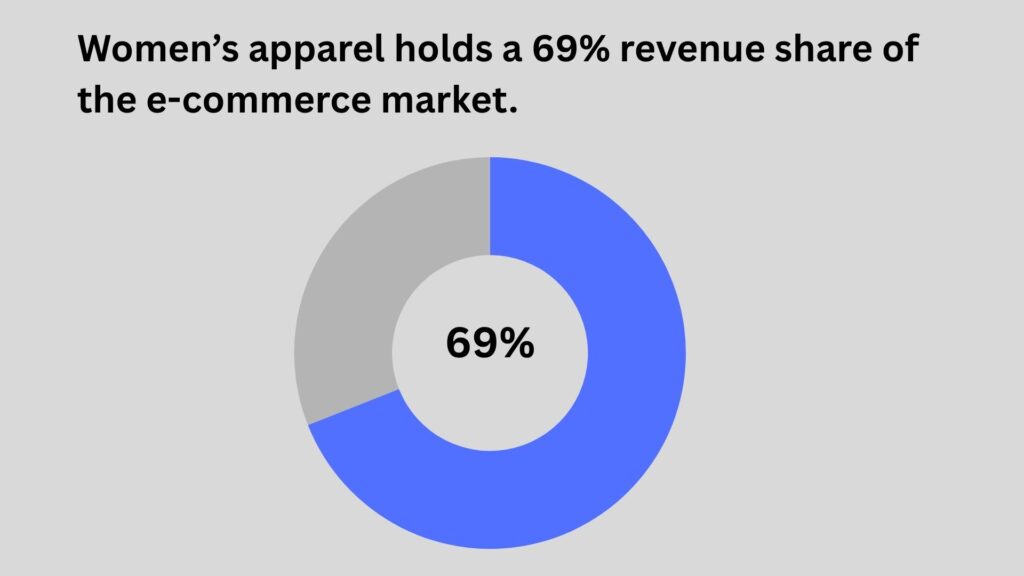
From 2018 to 2024, fashion e-commerce sales grew by a massive 73%. Globally, 57% of all internet users have bought clothing online.
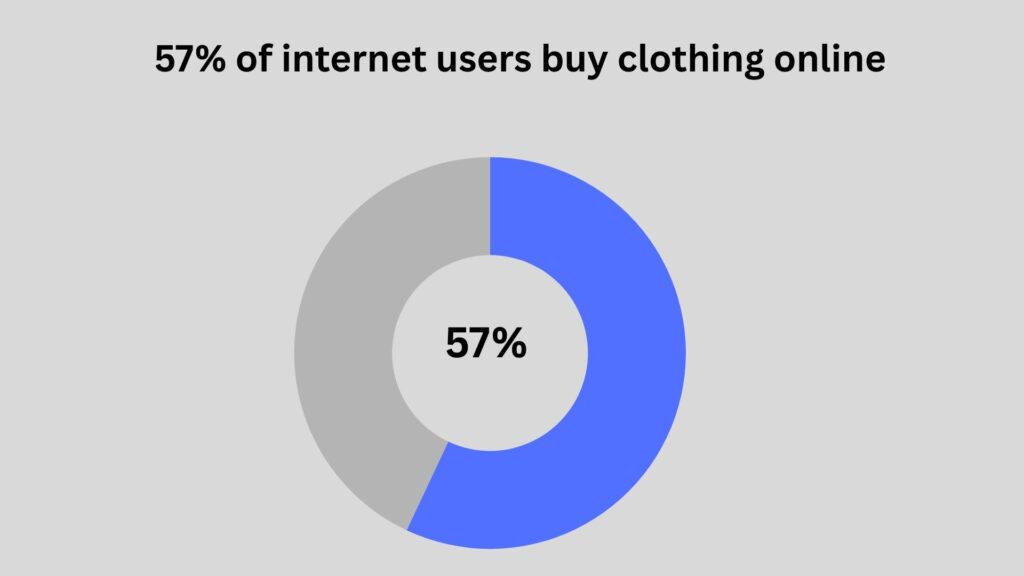
Roughly 80% of all visits to fashion shopping sites come from mobile phones. Retailers must focus on smartphone shopping experiences.
Sources: Precedence Research, Fireworks., Capital One Shopping, ECDB, MakersRow
How much did U.S. households spend on clothing in 2022?
On average, U.S. households spent about $162 per month on clothing, which adds up to roughly $1,945 for the year. This was a 10.9% increase compared to the previous year.
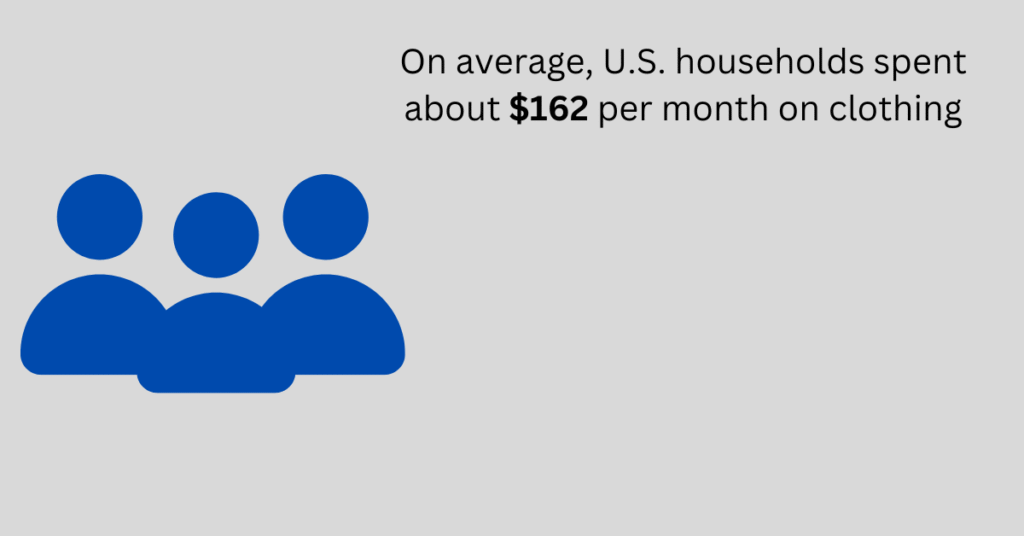
Sources: Uniform Market
How many garments are produced globally each year?
Over 100 billion garments are produced globally each year, fueling fast fashion trends. About 92 million tonnes of textile waste are generated each year and and at least three out of every five items purchased are discarded within a year.
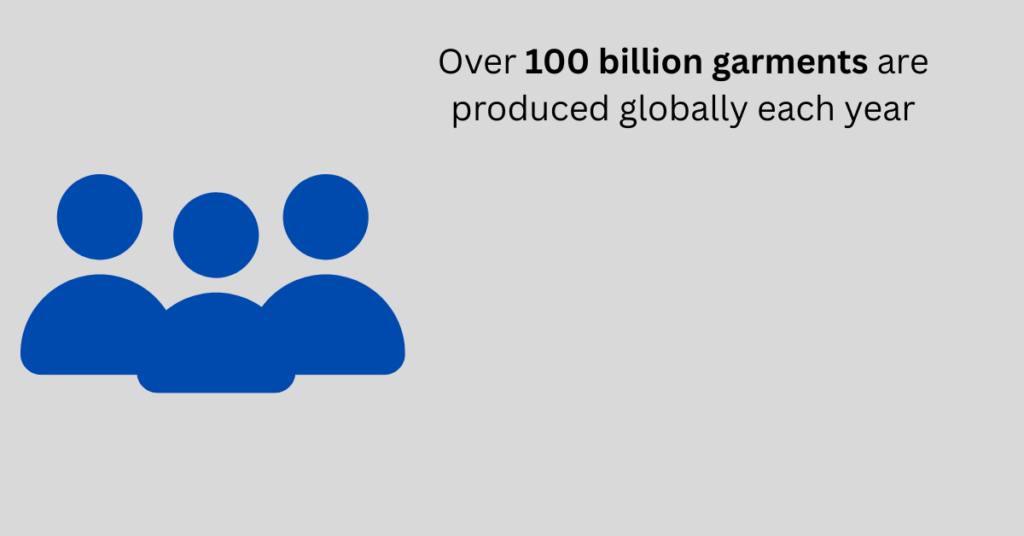
Sources: Uniform Market, ESG, UN Environment Programme
How many people work in the fashion and textile industry worldwide?
About 430 million people — roughly 12% of the global workforce work in the fashion and textile industry. Most of these jobs are concentrated in developing countries, where manufacturing and related activities (fibre production, garment assembly, and low-cost supply-chain roles) are largest.
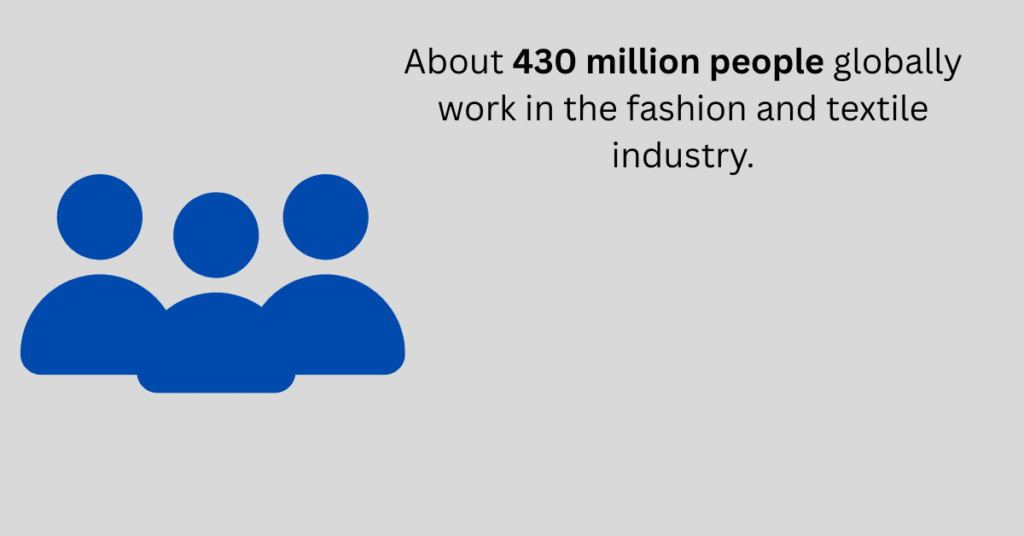
Sources: Uniform Market
U.S. Apparel Manufacturing Industry
How many people are employed in the U.S. apparel manufacturing industry in 2025?
The U.S. clothing sector employed only about 82,000 people in 2025. That relatively small number reflects that most clothing sold in the U.S. is produced overseas and imported, rather than made domestically.
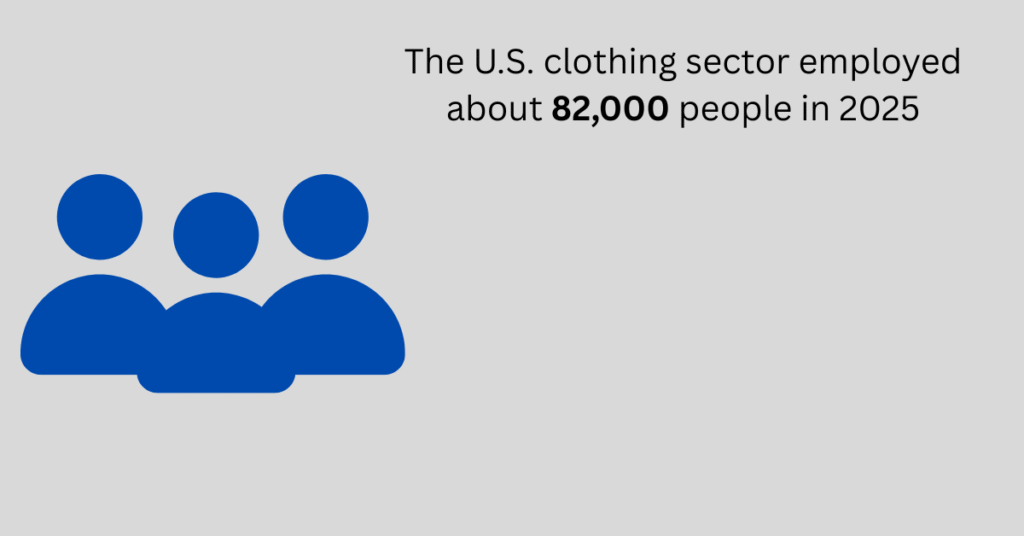
What is the largest occupation within the U.S. Apparel Manufacturing workforce?
The largest single occupation is Sewing machine operators, with 26,230 employed in 2024.
How many private establishments are in the U.S. Apparel Manufacturing Industry?
In the first quarter of 2025 (preliminary data), there were 6,322 private industry establishments in the Apparel Manufacturing subsector.
What are the typical earnings in U.S. apparel manufacturing?
The average hourly wage for all employees in the apparel manufacturing industry is about $24.03 (as of August 2025), while the median annual wage of $35,300 (as of 2024).
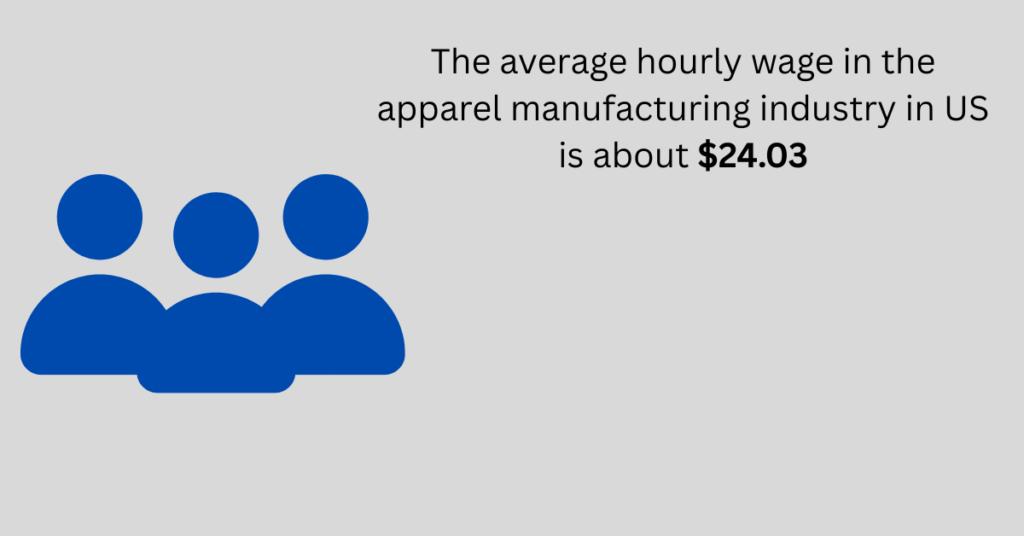
What was the change in unit labor costs for the apparel industry in the US in 2024?
The apparel industry experienced a significant cost pressure in 2024, as Unit Labor Costs rose by 7.1%. This metric, which tracks the labor expense required to produce a single item, shows that apparel manufacturers spent substantially more on labor per unit of output compared to the previous year.
Sources: U.S. Bureau of Labor Statistics, Uniform Market
Top Global Exporters of Clothing
In 2024, the European Union was the world’s largest apparel exporter, with shipments valued at 165.7 billion U.S. dollars. China followed closely behind, exporting about 165.2 billion U.S. dollars worth of apparel that year.
| Country/Region | Export Value (Billion USD) |
| European Union | 165.7 |
| China | 165.2 |
| Bangladesh | 38.5 |
| Vietnam | 33.9 |
| Turkey | 17.9 |
| India | 16.4 |
| Cambodia | 9.9 |
| Pakistan | 9.3 |
| Indonesia | 8.7 |
| United States | 7 |
Sources: Statista
Top Apparel and Clothing Accessories Importers
In 2023, the United States imported apparel worth $1,163.6 million, followed by the European Union at $460.9 million and Japan at $446.5 million. Together, these top three accounted for the largest share of global clothing imports.
| Country/Region | Trade Value (Million USD) | Quantity (Million Kg) |
| United States | 1163.56 | 80.31 |
| European Union | 460.97 | 81.53 |
| Japan | 446.49 | 112.99 |
| Vietnam | 280.98 | 19.17 |
| France | 160.93 | 22.82 |
| Netherlands | 126.11 | 8.49 |
| Germany | 122.27 | 15.6 |
| United Kingdom | 105.85 | 21.59 |
| Poland | 100.21 | 6.2 |
| Canada | 95.41 | 6.51 |
| Spain | 91.71 | 10.38 |
| Italy | 87.02 | 10.64 |
| Mexico | 56.27 | 12.05 |
| Australia | 56.04 | 3.87 |
| Saudi Arabia | 50.86 | 3.47 |
Sources: World Bank
The Environmental Impacts of the Clothing Industry
The fashion industry accounts for ~6–8% of global CO₂ emissions, totaling around 1.7 billion tonnes annually. Greenhouse gas emissions from the sector rose by 7.5% in 2023.
The garment industry is responsible for almost 20% of global industrial wastewater, mostly from dyeing fabrics. The clothing industry consumes 1.5 trillion liters of water annually.
Producing a single cotton T-shirt can require 2,700 liters of water, equivalent to what one person drinks in 2.5 years. Only about 8% of textile fibers were recycled into new textiles in 2023.
An estimated 85% of all textiles end up in landfills or are burned each year. This waste includes over $50 billion in discarded textiles that could be remade into fibers.
The sustainable clothing market was estimated between $3.6 billion and $9.22 billion in 2024. Also, 70% of EU textile emissions occur outside Europe, shifting the environmental burden abroad.
Sources: Earth.org, UNEP.org, ESGDive.com, BCG.com, KeyPointIntelligence.com, EEA.europa.eu, LatiColeathers.com, Fulgar.com, GMInsights.com
Supply Chain Risks and Diversification
Nearly 70% of large U.S. fashion companies sourced from ten or more countries in 2024. This shows companies are spreading out production to lower risks.
Despite diversification efforts, 72.7% of U.S. apparel imports still came from Asia in 2024. This confirms Asia remains the main production hub.
80% of retail executives expect new trade policies or tariffs to disrupt their supply chains. New tariffs could add nearly $35 billion in duties by 2025.
44% of retailers plan to reduce their reliance on imports because of these risks. 59% of consumers say higher import costs would make them buy more secondhand clothes.
Private-label clothing takes a long time, from 8 to 24 weeks for production and shipping. Fast-fashion bulk orders are much quicker, with lead times of only 7 to 15 days.
Sources: Newsroom.ThredUP.com, ShengluFashion.com, AECEgy.com, USFashionIndustry.com, AJGFashionConsulting.com, Modaknits.com
The clothing sector continues to expand, shaped by e-commerce, shifting consumer habits, and international trade flows. By understanding the latest global apparel industry statistics, businesses, retailers, and investors can make smarter decisions and stay competitive in this fast-moving market.
